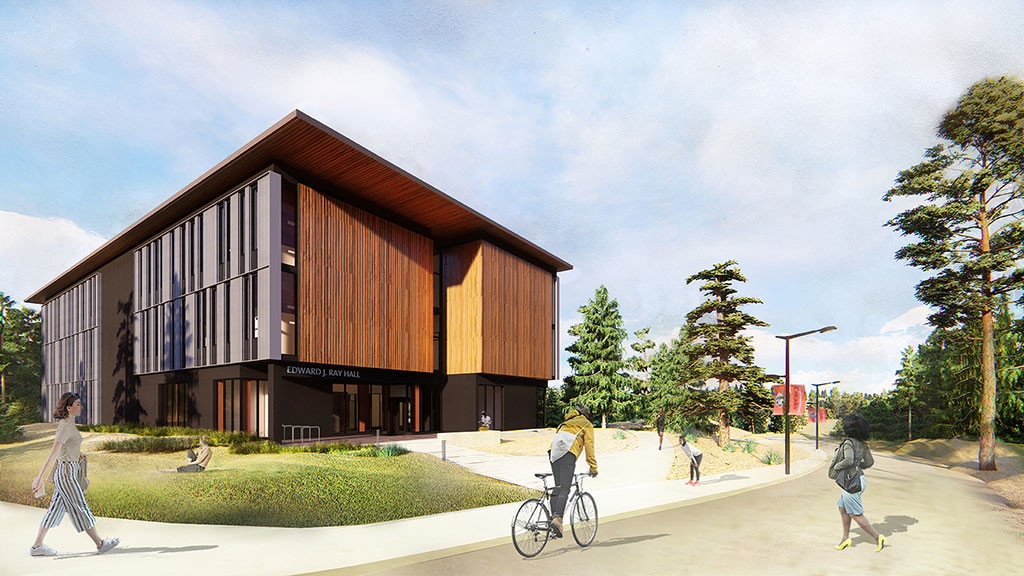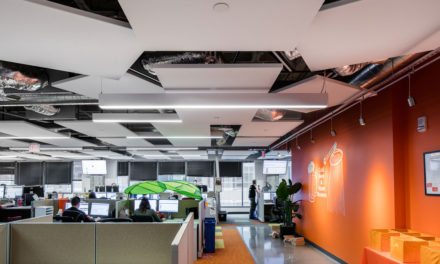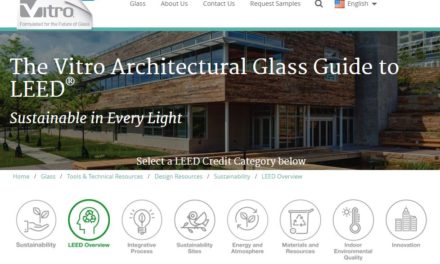Edward J. Ray Hall will provide a new learning environment for Science, Technology, Engineering, Arts, and Math on the Cascades Campus of the Oregon State University while creating a vibrant student hub with active interior and exterior spaces. Its design will elevate the University’s identity in Bend while exemplifying its commitment to sustainability with a Net Zero Energy target and a structure of regionally sourced mass timber.
As the first building to engage a 46-acre reclaimed pumice mine acquired by the University for future campus expansion, the 50,000-square-foot Edward J. Ray Hall will perch atop its steep eastern rim with panoramic views across the future west campus and to the mountains beyond. The building and its adjacent outdoor spaces will step with the topography to create a gateway and link between the existing upper campus and the future development that will occur in and around the bowl of the transformed mine.
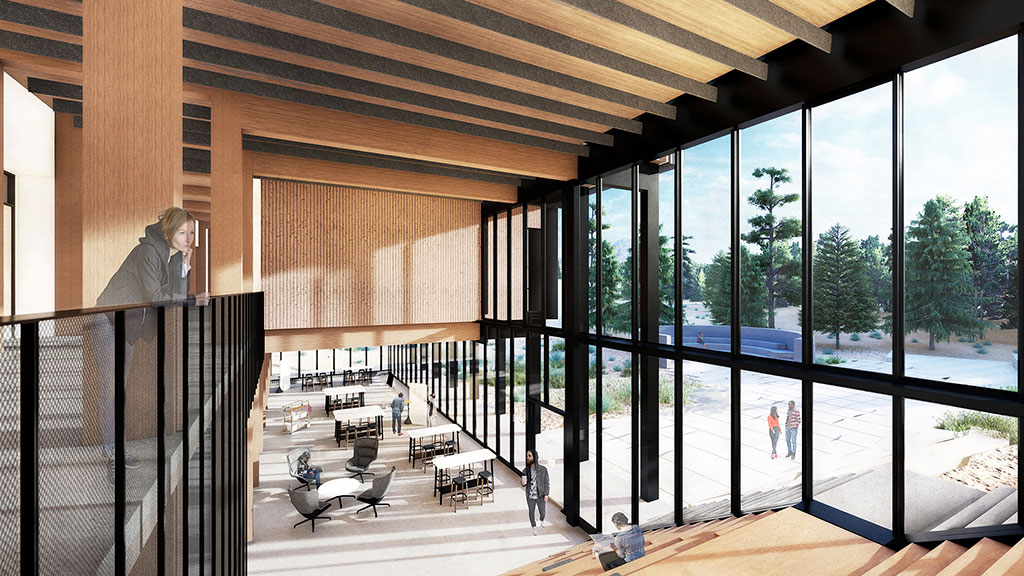
Rendering courtesy of SRG Partnership, Inc.
The selection of mass timber for the building’s structural system reinforces OSU-Cascades’ robust commitment to sustainability with the use of a locally sourced renewable material and the low-carbon footprint associated with its production. The natural beauty of the timber structure will be expressed in the building’s interior, creating a warm, inviting environment for students and faculty and visually connecting the building with the broader regional landscape.
Edward J. Ray Hall’s east/west orientation and exterior design will contribute to the Net-Zero Energy target established by the University. Primary façades will feature tall windows with a filigree of vertical shading devices tuned to their solar orientation to maximize daylighting and mitigate glare and summer heat gain. A broad horizontal roof plane floating above the mass of the building form will accommodate an array of photovoltaics to provide on-site renewable energy for the project.
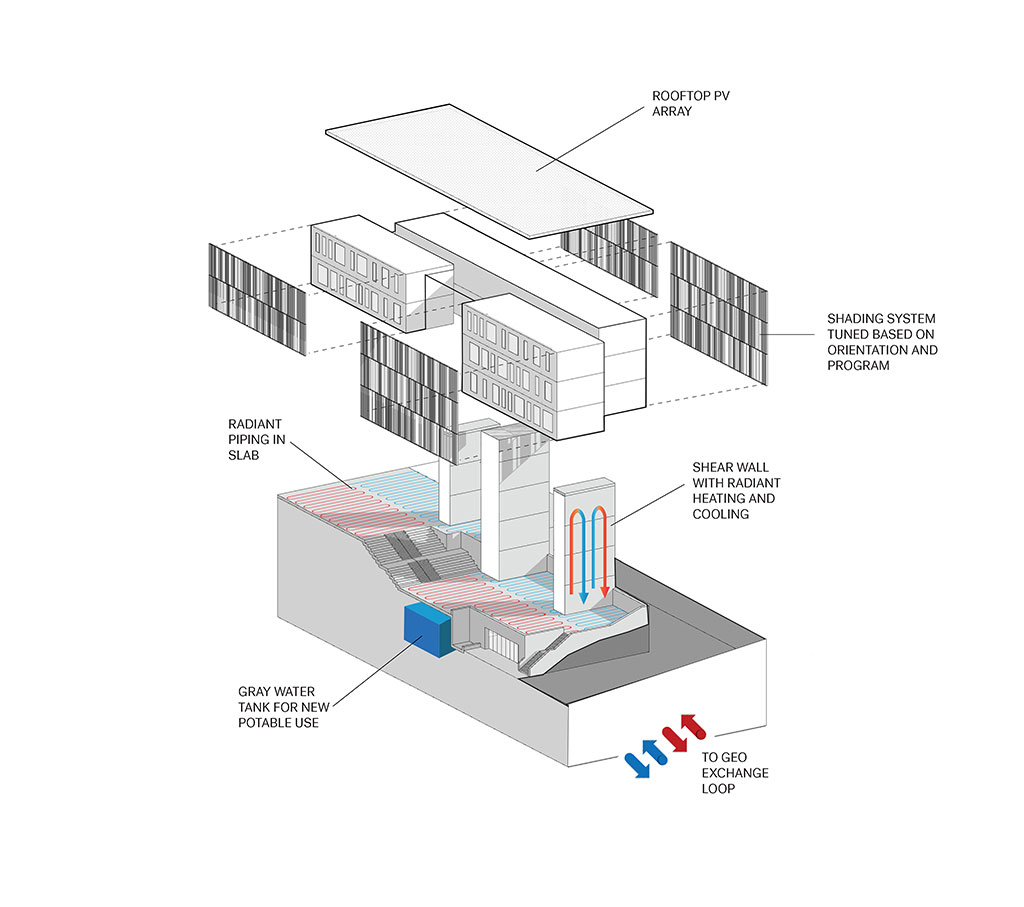
Courtesy of SRG Partnership, Inc
The building was conceived through a prototyping process focused on defining a new type of academic environment that would support a variety of educational activities and functions, promote interdisciplinary collaboration, and embody social equity and sustainability. The concept utilizes a centralized, flexible technology core paired with a modular grid to organize the multiple activity-based space typologies derived from project goals and objectives. The resultant prototype is a scalable, adaptable concept that will serve as the model for future buildings, with the ability to be tailored to each project’s unique opportunities, conditions and location.
SRG Partnership design team:
Laurie Canup, AIA, LEED AP BD+C, Principal-in-Charge
Carl Hampson, AIA, LEED AP, Design Principal
Lisa Petterson, AIA, LC, LEED AP BD+C, Senior Project Manager
Scott Mooney, AIA, LEED AP BD+C, Project Designer
David Webb, Assoc. AIA, LEED AP, Project Manager
Emily Wright, IIDA, Interior Designer
Jennah Byrd, LEED GA, Designer
Eric Ridenour, LEED AP ND, Campus Planner
Tim Evans, AIA, LEED AP BD+C, Lab Planner
Trevor Lavoie, AIA LEED AP BD+C, Project Architect
Consultant team
Architecture: SRG Partnership, Inc.
Lighting: SRG Partnership, Inc.
Interior designer: SRG Partnership, Inc.
Contractor: Swinerton
Civil Engineer: DOWL
Structural Engineer: Catena Consulting Engineers
Mechanical Engineer: Affiliated Engineers, Inc. (AEI)
Plumbing Engineer: Affiliated Engineers, Inc. (AEI)
Electrical Engineer: Samata Consulting Engineers LLC
Geotechnical Engineer:
Landscape: Swift Company LLC
Cost: JMB Consulting Group LLC
Code: Code Unlimited LLC
Accessibility: Studio Pacifica Ltd.
Acoustical Engineer: ABD Engineering and Design
Wind Engineer: CPP
Geotechnical Engineer: GRI
Materials/Products
Mass Timber sourced from Vaagen Timbers
Cascadia Windows
Cedar cladding sourced from Sustainable Northwest
Jaga sensible fan-coil heat/cooling units

